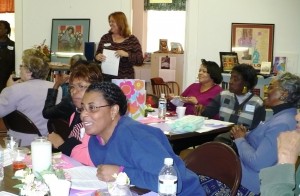 My home base for ministry is in former classrooms on a seminary campus. There is a place to view videos and a children’s corner, tables and chairs here and there, and shelves everywhere. On the shelves are curriculum and periodicals, puppets and games, videos and DVDs, an authentic Hebrew scroll in its satin cover – – books, of course, and periodicals. There are filing cabinets containing folders filled with the best clippings, articles and indispensable ideas gleaned over the years, several deep files for teaching pictures, a storage rack especially designed for us to contain our growing art collection – – and a wonderful old chest. Once that chest stored maps or blueprints, but now it is the ideal refugefor those large posters and vulnerable unframed prints we treasure.
My home base for ministry is in former classrooms on a seminary campus. There is a place to view videos and a children’s corner, tables and chairs here and there, and shelves everywhere. On the shelves are curriculum and periodicals, puppets and games, videos and DVDs, an authentic Hebrew scroll in its satin cover – – books, of course, and periodicals. There are filing cabinets containing folders filled with the best clippings, articles and indispensable ideas gleaned over the years, several deep files for teaching pictures, a storage rack especially designed for us to contain our growing art collection – – and a wonderful old chest. Once that chest stored maps or blueprints, but now it is the ideal refugefor those large posters and vulnerable unframed prints we treasure.
By this time you may have guessed that my place of ministry is a resource center – – actually, The Resource Center. “TRC”, as it is known locally, is never as tidy and organized as I would wish it to be. Some days I look around with love and see creative disarray; on other days I see clutter! What do these thingshave to do with ministry? How does one do ministry in the midst of so much stuff? What does it have to do with Christian formation, and how does one speak of it theologically? Is there such a thing as a ministry of resourcing?
Several years ago, in a video called The Resource Center, produced by the National Training Center for Resource Center Directors, Dr. David Graybeal of Drew Theological Seminary points out that a resource is defined as something needed to fulfill some purpose. It is a concept that has ancient and spiritual meaning for the church. Beginning with the first few chapters of Genesis we learn that God filled the world with resources – – everything that was required for human life. Later, for Moses and the Hebrew people, there was the cloud and the pillar of fire, manna and water from the rock. As they settled into the new land, the people themselves were called upon to be resources to nature, becoming vine-dressers, shepherds, herdsmen and planters.
 The pages of scripture are filled with wonderful stories of people being resources to one another, Ruth and Naomi, David and Jonathan, Jesus and his disciples. Then, when those disciples feared their most precious resource was lost, God sent the Holy Spirit – – a resource that could never be diminished or depleted, a resource that empowered them for ministry.
The pages of scripture are filled with wonderful stories of people being resources to one another, Ruth and Naomi, David and Jonathan, Jesus and his disciples. Then, when those disciples feared their most precious resource was lost, God sent the Holy Spirit – – a resource that could never be diminished or depleted, a resource that empowered them for ministry.
As the letters of Paul were gathered, then the gospels, and both were added to Hebrew scriptures, the Bible became, and remains, the central resource for the church. The church continued to create other resources through the centuries: cathedral windows that told stories, bible translations made possible by the printing press. In the 19th century Sunday schools were established so all ages could study the Bible together. In the 20th century, in order to compete for attention with billboards and radio, churches began to produce print resources, later followed by the adoption of new visual aids: flannel boards and slide shows, filmstrips, movies, videos. Demands on the church increased, and the range of resources became greater and more costly. Now, early in the 21st century, churches are learning to use not only websites and e-mail, but blogs and e-zines and more, as we increase our comfort level in cyberspace. To be heard today, the church must still compete for attention.
The point, of course, is still to tell the old, old story but we must tell it in ever new ways. The ministry of resourcing is about helping churches tell that story in ways which speak to today’s children, youth and adults. Putting the right resources into the hands of those engaged in Christian formation, providing the right information at the right time, whether to highly educated professionals or to committed volunteers, is a form of ministry. Storing and maintaining costly resources where they can be shared by many churches is good stewardship.
On those days when I look around at the things on our shelves, I often remember one of my early visits there when the director, Ginna Minasian Dalton, gave me a guided tour. A decade later Ginna was to become my mentor in resourcing. “This place,” she explained, “isn’t about resources. It isn’t about things. It’s about creating life, the life that is created between persons when they share each other’s faith journey, even for a short time. The things, the resources you place in another person’s hands, are of no value unless they contribute to a journey you both have shared.”
The gospel is inherently about communication, and resources are vehicles of communication. My contribution to Christian formation as a resource center director is to place the best vehicle of communication I can find in the hands of another, sending them off on their own journey with a plan for using that resource. Paul’s words in Romans sum up what I believe to be the spirit of good resourcing: I am longing to see you so that I may share with you some spiritual gift to strengthen you . . . or rather so that we may be mutually encouraged by each other’s faith, both yours and mine. (Romans 1:11-12 TEV)
